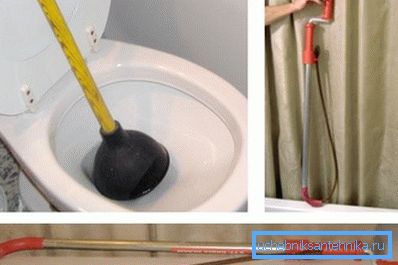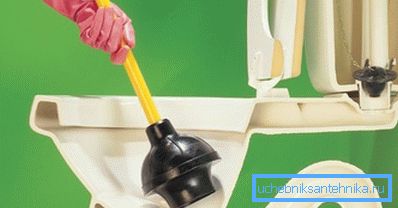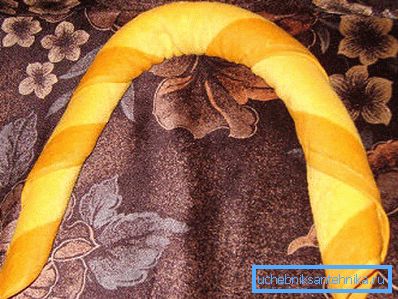What to do if the toilet is clogged: the simplest ways to
A sign of high-quality home sewage is the normal throughput of sewage pipes and hydraulic seals of sanitary devices. However, sooner or later, over time, any sewage system can form a blockage, which leads to a decrease in throughput and, in some cases, to a complete blockage of sanitary appliances or a drain collector.
At the same time, when the question arises: what to do if the home methods in the toilet can also be very useful, because they can solve the problem without asking for help from professional plumbers.

Simple ways to clean the toilet
The clogging of water locks on small plumbing fixtures (sink, bathtub, shower) can be easily removed at home by disassembling and cleaning the siphon, while the water seal in the toilet bowl is maintenance-free, so it can be cleaned only through a drain hole.
In order for any reader to do this simple work on their own, this article will describe a step-by-step instruction that discusses the basic methods of cleaning the toilet bowl using the simplest household tools.

Mechanical cleaning of the toilet bowl
The most effective and radical means of eliminating strong blockages caused by the ingestion of rags, large food debris, or small household waste is to clean the toilet bowl with a special sanitary cable. It is a flexible but resilient metal cable enclosed in a rigid outer sheath.
At one end there is a handle for rotation, and at the other end are removable tips for loosening, pushing, or picking up accumulated debris, depending on the nature of the resulting blockage.
- Before you begin cleaning, you need to accurately determine the place of formation of blockages, and make sure that it is in the toilet trap., or adjacent drain sewer.
- Shut off the taps of all plumbing fixtures, to prevent ingress of domestic sewage into the domestic sewer system.
- Install a suitable tip on the working end of the cable., and drive it as deep as possible into the drain hole of the toilet bowl.
- Constantly rotating the handle, push the cable into the depth of the sewer system, until its tip reaches the site of the blockage.
- After the cable rests on the accumulation of garbage, you need to stir it up, and try to push in the direction of the drain riser, or hook the hook, and pull over yourself through the drain hole of the toilet bowl.

Note! In addition to manual cables for cleaning sewage, there are also mechanized models equipped with an electric motor, but it makes no sense to buy them for home use, since their price will many times exceed the cost of calling a professional plumber.
Chemical cleaning method
The use of special household chemicals made on the basis of caustic soda is considered to be a simpler, but no less effective way to combat the blockage of toilet bowls. This method is good to use for removing hair, plant fibers, food debris, as well as lime and fat deposits, which eventually accumulate in pipes and hydraulic locks of any home sewage system.
Its advantage is that it does not require physical effort, so any housewife can cope with the removal of the blockage in the toilet.
- Before using a chemical agent, it is necessary to carefully read the instructions on the package, and in the course of work it is necessary to use personal protective equipment (rubber gloves, protective glasses).
- In accordance with the instructions, in the drain hole of the toilet you need to pour 250 - 500 ml of a chemical agent, and leave it alone for one and a half or two hours.
- In the course of a chemical reaction, gases with a strong unpleasant odor can be emitted from the drain hole, so the toilet door should be tightly closed at this time.
- After the expiration of the specified time, it is necessary to thoroughly ventilate the room, and several times to drain the water from the drain tank in order to flush the sewage system from reagents and dissolved organic matter.

Tip! To prevent further formation of blockages, chemical cleaners in a weaker concentration (1: 2) are recommended for prophylactic purposes at least once every two months.
Use of folk remedies
The simplest household tool for cleaning home sewage is the well-known plunger. The technique of using it is familiar to many, but it may happen that if a blockage occurs, it will not be at hand.
In this case, can come to the aid of folk remedies using ordinary objects that can always be found in any home.
- From the drain hole of the toilet bowl, remove most of the water, and pour one glass of soda ash into it, and then, as far as possible, push it deep into the pipe.
- Observing caution, pour 400-500 ml of table vinegar (9%) or diluted acetic acid into the drain hole, and wait 15-20 minutes before the end of the violent reaction.
- After that, pour a thin stream of 2-3 liters of boiling water over it, preventing it from falling on the ceramic walls of the toilet bowl, and then rinse the system abundantly with cold water.

Another one life hack allows you to make a kind of ordinary plunger from a small terry towel or a waffle towel in a short time:
- Take an unnecessary old towel by the short ends, twist and fold it in half so that a thick thick rope forms, the ends of which, for convenience, need to be tied with string or rope.
- Holding the hand tightly, insert the harness as far as possible into the drain hole of the toilet bowl so that it fills the internal lumen of the tube.
- Perform several energetic reciprocating movements of the harness. At the same time, it will create alternate overpressure, and a vacuum in the pipe, which will allow to budge and remove the resulting plug.

Conclusion
Finally, it should be noted that the use of the above methods will be effective only if a local blockage is formed in the domestic sewer network. If the common drain riser of an apartment building is clogged, you will need to seek help from plumbers from the housing department.
To get a visual idea of cleaning the toilet, it is recommended to view the video in this article, as well as read other similar articles on our website.